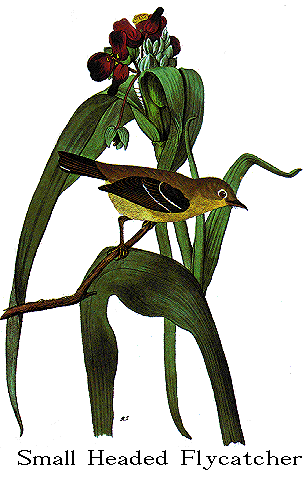Birds of America
By John James Audubon, F. R. SS. L. & E.
VOLUME I.



Family
Genus

SMALL HEADED FLYCATCHER.
[Small-headed Flycatcher.]
MUSCICAPA MINUTA, Wilson.
[Sylvania microcephala.]

PLATE LXVII.--MALE.
The sight of the figure of this species brings to my recollection a curious
incident of long-past days, when I drew it at Louisville in Kentucky. It was in
the early part of the spring of 1808, thirty-two years ago, that I procured a
specimen of it while searching the margins of a pond.
In those happy days, kind reader, I thought not of the minute differences
by which one species may be distinguished from another in words, or of the
necessity of comparing tarsi, toes, claws, and quills, although I have, as you
are aware, troubled you with tedious details of this sort. When ALEXANDER
WILSON visited me at Louisville, he found in my already large collection of
drawings, a figure of the present species, which, being at that time unknown to
him, he copied and afterwards published in his great work, but without
acknowledging the privilege that had thus been granted to him. I have more than
once regretted this, not by any means so much on my own account, as for the sake
of one to whom we are so deeply indebted for his elucidation of our ornithology.
I consider this Flycatcher as among the scarcest of those that visit our
middle districts; for, although it seems that WILSON procured one that "was shot
on the 24th of April, in an orchard," and afterwards "several individuals of
this species in various quarters of Now Jersey, particularly in swamps," all my
endeavours to trace it in that section of the country have failed, as have those
of my friend EDWARD HARRIS, Esq., who is a native of that State, resides there,
and is well acquainted with all the birds found in the district. I have never
seen it out of Kentucky, and even there it is a very uncommon bird. In
Philadelphia, Baltimore, New York, or farther eastward or southward, in our
Atlantic districts, I never saw a single individual, not even in museums,
private collections, or for sale in bird-stuffers' shops.
In its habits this species is closely allied to the Hooded and Green
Blackcapt Flycatchers, being fond of low thick coverts, whether in the interior
of swamps, or by the margins of sluggish pools. from which it only removes to
higher situations after a continuation of wet weather, when I have found it on
rolling grounds, and amid woods comparatively clear of under-growth.
Differing from the true Flycatchers, this species has several rather
pleasing notes which it enunciates at pretty regular intervals, and which may be
heard at the distance of forty or fifty yards in calm weather. I have more than
once seen it attracted by an imitation of these notes. While chasing insects on
wing, although it clicks its bill on catching them, the sound thus emitted is
comparatively weak, as is the case with the species above mentioned, it being
stronger however in the Green Blackcapt than in this or the Hooded species.
Like these birds, it follows its prey to some distance at times, whilst, at
others, it searches keenly among the leaves for its prey, but, I believe, never
alights on the ground, not even for the purpose of drinking, which act it
performs by passing lightly over the water and sipping, as it were, the quantity
it needs.
All my efforts to discover its nests in the lower parts of Kentucky, where
I am confident that it breeds, have proved fruitless; and I have not heard that
any other person has been more successful.
SMALL-HEADED FLYCATCHER, Muscicapa minuta, Wils. Amer. Orn.,
vol. vi. p. 62.
SYLVIA MINUTA, Bonap. Syn., p. 86.
SMALL-HEADED SYLVAN FLYCATCHER, Nutt. Man., vol. i. p. 296.
SMALL-HEADED FLYCATCHER, Muscicapa minuta, Aud. Orn. Biog.,
vol. v. p. 291.
Wings short, the second quill longest; tail of moderate length, even;
general colour of upper parts light greenish-brown; wings and tail dark
olive-brown, the outer feathers of the latter with a terminal white spot on the
inner web; a narrow white ring surrounding the eye; two bands of dull white on
the wing; sides of the head and neck greenish-yellow, the rest of the lower
parts pale yellow, gradually fading into white behind.
Male, 5, 8 1/4.
Kentucky, Pennsylvania, and New Jersey. Exceedingly rare. Migratory.
THE VIRGINIAN SPIDERWORT.
TRADESCANTIA VIRGINICA, Willd., Sp. Pl., vol. ii. p. 16. Pursch, Fl.
Amer., vol. i. p. 218.--HEXANDRIA MONOGYNIA, Linn.--JUNCI, Juss.
This species is distinguished by its erect, succulent stem; elongated
lanceolate, smooth leaves; and umbellate, subsessile flowers, which are of a
deep purple colour, with yellow anthers.









